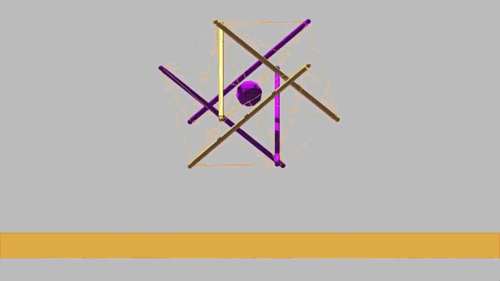
Landing an unmanned robot on another planet can be quite a feat and can end up being quite a complex process. Scientists want to make this process easier but also allow us to explore worlds that are currently too difficult to land on.
UC Berkeley professor Alice Agogino is working with doctoral students to build what are known as tensegrity robots. Essentially, these are robots built with a series of rods and tension wires that protect the delicate scientific instruments in the middle.
The structure allows for both flexibility and strength while navigating a rugged environment — for example, landing on a planet’s rocky surface. These robots can explore places that are currently inaccessible to wheeled rovers such as rocky cliffs, which are rich in geological data due to the exposed rock.
Currently, NASA researchers are working on a prototype to one day land on places such as Titan – one of Saturn’s moons. Scientists are interested in this moon because it has a thick atmosphere with flowing liquids on the surface and is often referred to being the most earthlike world in our solar system.

The design of this tensegrity robot is not only unique but interesting. With a shape that resembles that of the carbon compound buckminsterfullerene, the design by these scientists is quite phenomenal. Of note is the contrast in design between this tensegrity robot and the tensegrity robot built by a group of students from the University of Idaho which fundamentally has a central spine, giving it the shape and structure of a snake (Sunspiral. V, 2012, Tensegrity Snake Robot[ONLINE], http://www.magicalrobot.org/BeingHuman/2012/10/tensegrity-snake-robot). Though both robots are essentially for outer-space exploration, the differences in design which translate to differences in approach to this field of science give a very optimistic outlook to the further advancements in knowledge of outerspace.
The marked departure from mainstream robot forms for space exploration to more function-specific forms in the last ten years has been remarkable especially considering that some of the most fundamental ideas behind this research are close to 40 years old. It is in the 1960s that Buckminster Fuller is credited as having coined the portmanteau “tensegrity” for the phrase, tensional integrity. Not surprisingly, it is the same underlying principles of tension in structures which are being made use of by leading scientists in tensegrity research like Adrian Agogino and Vytas Sunspiral
Understanding the complexity of prior unmanned landings on Mars has helped me realise just how important a breakthrough in building tensegrity robots would be. The complexity seems to emanate from the delicate and fragile structure of the current robots which are have the shape of a car; yet with the tensegrity robots the side on which they land is not important. Coupled with this benefit is the advantage that tensegrity barely have a limitation as to their area of movement, as with the current robots deployed on Mars because of them being bulky. The rugged terrain of some of the planets on which it is currently not feasible to make a landing, will not be a factor to determine making a landing or not as tensegrity robots are not dependant on smooth ground. It is now left to be soon just how soon the plans for the tensegrity robots will come to fruition.